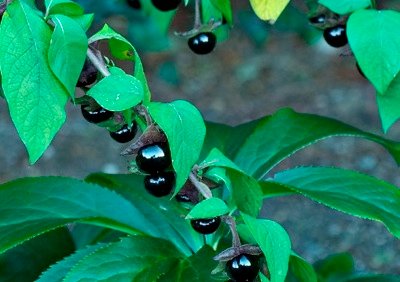Belladonna
Atropa belladonna
[Devil's Berries, Deadly Nightshade]
Know Your Source
Belladonna is a perennial herbaceous plant in the family Solanaceae, native to Europe, North Africa, and Western Asia. The foliage and berries are extremely toxic, containing tropane alkaloids. These toxins include scopolamine and hyoscyamine which cause a bizarre delirium and hallucinations, and are also used as pharmaceutical anticholinergics.
The drug atropine is derived from the plant. [Wikipedia] It was called Belladonna because Italian women used it to dilate their pupils, making their eyes sparkle.
It was proved by Hahnemann in 1799 and used with great success in the treatment and prevention of Scarlet Fever, whose symptoms closely resemble those of Belladonna poisoning.
Key Symptoms
- Hot, flushed, red face
- High fever
- Delerium
- Desire for sour things
- Sensitivity to light, noise, and movement
Watch this video
Belladonna Keynotes
[H C Allen]Adapted to bilious, lymphatic, plethoric constitutions; persons who are lively and entertaining when well, but violent and often delerious when sick.
Women and children with light hair and blue eyes, find complexion, delicate skin; sensitive, nervous, threatened with convulsions; tuberculous patients.
Great liability to take cold; sensitive to drafts of air, especially when uncovering the head; from having the hair cut; tonsils become inflamed after riding in a cold wind (Acon., Hep., Rhus - takes cold from exposure of feet, Con., Cup., Sil.).
Quick sensation and motion; eyes snap and move quickly; pains come suddenly, last indefinitely and cease suddenly (Mag. p.).
Pains usually in short attacks; cause redness of face and eyes; fulness of head and throbbing of carotids.
Imagines he sees ghosts, hideous faces, and various insects (Stram.); black animals, dogs, wolves.
Fear of imaginary things, wants to run away from them; hallucinations.
Violent delirium; disposition to bite, spit, strike and tear things; breaks into fits of laughter and gnashes the teeth; wants to bite and strike the attendants (Stram.); tries to escape (Hell.).
Head hot and painful; face flushed; eyes wild, staring, pupils dilated; pulse full and bounding, globular, like buckshot striking the finger; mucous membrane of mouth dry; stool tardy and urine suppressed; sleepy; but cannot sleep (Cham., Op.).
Convulsions during teething, with fever (without fever, Mag. p.); come on suddenly, head hot, feet cold. Rush of blood to head and face (Amyl., Glon., Mel.).
Headache, congestive, with red face, throbbing of brain and carotids (Met.); < from slight noise, jar, motion, light, lying down, least exertion; > pressure, tight bandaging, wrapping up, during menses.
Boring the head into the pillow (Apis, Hell., Pod.). Vertigo when stooping, or when rising after stooping (Bry.); on every change of position.
Abdomen tender, distended < by least jar, even of the bed; obliged to walk with great care for fear of a jar.
Pain in right ileo-coecal region, < by slightest touch, even of the bed- cover.
The transverse colon protrudes like a pad.
Skin: of a uniform, smooth, shining scarlet redness; dry, hot, burning; imparts a burning sensation to examining had; the true Sydenham scarlet fever, where eruption is perfectly smooth and truly scarlet.
Pressing downwards as if the contents of abdomen would issue from the vulva; > standing and sitting erect; worse mornings (Lil., Mur., Sep.).
Relations. - Complementary: Calcarea. Belladonna is the acute of Calcarea, which is often required to complete a cure. Similar: to, Acon., Bry., Cic., Gels., Glon., Hyos., Mel., Op., Stram.
Aggravation. - From touch, motion, noise, draught of air, looking at bright, shining objects (Lys., Stram.); after 3 p. m.; night, after midnight; while drinking; uncovering the head; summer sun; lying down.
Amelioration. - Rest; standing or sitting erect; warm room.
